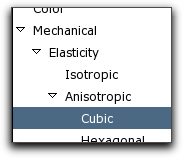OOF2: The Manual
Name
PropertyRegistration — Register new Properties
Synopsis
from oof2.engine.propertyregistration import PropertyRegistration
class PropertyRegistration:
def __init__(self, name, subclass, modulename, ordering,
params=[], fields=[], fluxes=[],
propertyType=None, outputs=[],
nonlinear=0, secret=0,
tip=parameter.emptyTipString, discussion=parameter.emptyTipString)
Description
Every new Property
class must have a single
PropertyRegistration object. The
PropertyRegistration contains meta-data
about the Property and inserts it in
the global list of all Property
classes, which allows it to appear in the user interface.
PropertyRegistrations are defined only
in Python, even for Properties that are
defined in C++. This means that all C++
Property subclasses must be swigged. It's
sufficient to swig the class and the constructor. Other
methods do not have to be made available in Python.
PropertyRegistration constructor parameters
The only required parameters are name,
subclass, modulename,
and ordering. The others can all be
omitted if they're not needed for a particular
Property. The default values for the
optional parameters are given in the synopsis, above.
When creating a PropertyRegistration,
it's advisable to use Python keyword arguments so that it's
clear which parameters have been omitted.
name-
nameis a string containing the name of theProperty, as it will appear in scripts and in the GUI. In the GUI,Propertiesare arranged hierarchically in a tree. Thenameis a colon separated string, in which each segment is a branch of thePropertytree. For example, the cubic elasticity property'snameisMechanical:Elasticity:Anisotropic:Cubic, and it appears in the GUI like this:
subclass-
This is the
Propertyclass that is being registered. It must either be a swigged C++Propertysubclass, a Python class derived from a swigged C++Propertysubclass, or a Python class derived fromPyPropertyWrapper. Note that the argument is the actual class, not an instance of the class. modulename-
modulenameis a string containing the name of the Python module in which the Python interface to the class is defined. For example, if the swig output file isshoofly.pyin directoryXYZwhich is in the Python path, thenmodulenamewould be'XYZ.shoofly'. ordering-
orderingdetermines thisProperty's position when listed in the GUI. It has no other significance. It can be either an integer or a floating point number. (Nodes of thePropertytree in the GUI are listed in order of increasingordering. Theorderingof an intermediate node in the tree is taken to be the smallestorderingof any of its children.) params-
The arguments for every
Property's constructor are a name, a registration, and a variable number of additional values that quantify theProperty's behavior. These additional arguments are determined by thePropertyRegistration'sparamsargument.paramsis a Python list ofParametersubclass instances. Each entry in the list specifies a type (which is implied by theParametersubclass), a constructor argument name, a default value, and a help string. The parameters must appear in the same order in theparamslist as they do in theProperty's constructor's argument list.For example, a mass density
Propertycould have aFloatParametercalleddensity,params=[FloatParameter('density', value=1.0, tip='mass density')]while a triclinic thermal expansion
Propertywould have aTriclinicRank2TensorParameter(for the modulus) and aFloatParameterfor the zero-stress temperature:params = [TriclinicRank2TensorParameter( name='alpha', value=TriclinicRank2Tensor(xx=1, yy=1, zz=1), tip='Thermal expansion tensor'), FloatParameter('T0', 0.0, tip='Stress free temperature') ]See Parameter for a list of all of OOF2's built-in
Parametertypes and their constructor arguments. fields-
This is a list of
Fieldobjects, indicating whichFieldsthePropertydepends upon. ThePropertywill not be used unless all of theFieldsin the list are defined on the mesh being solved. fluxes-
This is a list of
Fluxobjects, indicating whichFluxesthePropertycontributes to. ThePropertywill not be used unless some of theFluxesin the list are used in the activeEquations. propertyType-
The
propertyTypeis a string that categorizes theProperty. No twoPropertiesin aMaterialcan have the samepropertyType. The functionMaterial::fetchPropertylocatesPropertiesby theirpropertyType.When registering a new
Property, it's important to use the samepropertyTypethat was used for otherPropertiesof that type. The existing OOF2propertyTypesare given in Table 8.3. outputs-
outputsis a list of strings, each one the name of anPropertyOutputto which theProperty'soutputfunction contributes. nonlinear-
nonlinearshould be set to 1 if nonlinear solvers will be needed to solve a mesh containing thisProperty. Generally, this means that thePropertycontains quantities that areFielddependent. secret-
secretshould be set to 1 if thePropertyshouldn't appear in the GUI. This should not be used except by those who know what they're doing. tip-
tipis a short string describing theProperty. It should be something suitable for displaying as a pop-up tooltip in the GUI. discussion-
discussionis a longer string describing theProperty, meant to be included in the OOF2 manual. The string should be written in DocBook XML. The manual will embed it inside a<refsect1>element.[62]Since it's often inconvenient to include large blocks of text inside a
PropertyRegistration, the text can be put into a separate file. The file name can be passed to the functionloadFilefrom theoof2.common.IO.xmlmenudumpmodule. Thendiscussionshould be set to the return value fromloadFile. (loadFiledoesn't actually read the file unless the users manual is being generated, so there's no cpu or memory used when doing it this way, and the file often doesn't even have to be distributed with the code.) In any case, thediscussionargument is optional. A generic message will be generated if it's absent.
Property Types
The following table lists the propertyTypes
used in OOF2 PropertyRegistrations.
Not all of the types listed here are fully available yet
— some are still in development or reserved for future
use.
Table 8.3. Property Types
|
|
Description |
|---|---|
|
|
Spatial charge distribution |
|
|
Dielectric permittivity |
|
|
Elastic modulus |
|
|
Externally applied body force density |
|
|
Heat sources and sinks |
|
|
Heat capacity |
|
|
Mass density, for dynamic equations |
|
|
Crystalline orientation |
|
|
Piezoelectric modulus |
|
|
Plastic deformation rules |
|
|
Thermal conductivity |
|
|
Thermal expansion tensor and stress-free temperature |



